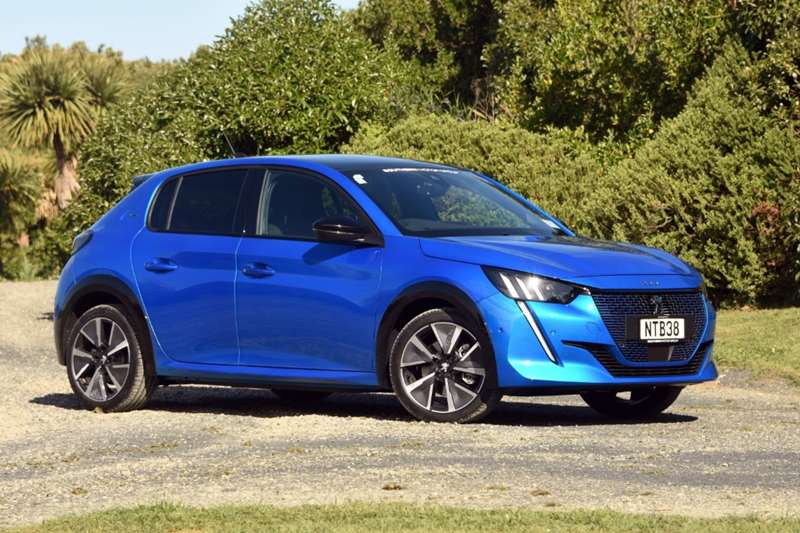There’s an all-electric member of Peugeot’s latest 208 hatchback, and David Thomson has been checking it out.
WHAT’S NEW?
When Peugeot’s engineers began work on the latest 208 compact hatchback, they already knew that a fully-electric derivative would be an important part of the mix alongside fossil-fuelled offerings. As a result, the vehicle was designed from the get-go for the optimal installation of both internal combustion and pure EV drivetrains.
Core EV requirements are pretty standard these days, encompassing as they do the electric motor, a bulky and heavy battery pack to power it, and associated ancillaries. However, with electric drive technology still evolving, there is still plenty of room for choice and innovation within these parameters. So, while it looks like an utterly conventional (and decidedly pretty) small hatchback, the e-208 features ample innovation under the skin.
The battery pack, for example, is not mounted in the usual single flat slab, but as a series of segments that fit into the various spaces that are in the petrol 208 occupied by internal-combustion componentry such as the fuel tank, exhaust system and catalytic converter. This enables a 50kWh battery to be installed without any loss of interior or boot space.
The braking system seamlessly integrates regenerative and conventional friction braking, the latter only engaging when maximum regenerative effect has been achieved. Among other interesting technical features, a heat-pump is used to operate the climate control.
Peugeot NZ offers this, its second generation 208, in two guises.
Conventional tastes are met by the standard 208 GT, a $37,990 machine that is powered by a 96kW/230Nm 1.2-litre three-cylinder turbo-petrol motor. The e-208 carries a heftier price tag — $61,990 before the Government’s $8625 EV rebate is applied — and provides a 100kW/260Nm drivetrain, along with zero-emissions motoring.
WHAT COMES AS STANDARD?
Standard creature comfort and convenience features include keyless entry, climate control air-conditioning, heated front seats, heated exterior mirrors, colour-configurable interior lighting, and a six-speaker audio system. The main ICT interface is a 10-inch centre touchscreen, which operates in conjunction with the e-208’s ‘‘3-D’’ main instrument panel. Voice recognition and smartphone mirroring for both Apple and Android is also provided, and there are dual USB sockets front and rear, as well as a front-mounted 12-volt plug point.
Key safety items include adaptive radar cruise control with stop-go functionality, auto-dipping LED headlights, semi-autonomous lane keeping assist, emergency braking with pedestrian and cyclist detection, and blind spot monitoring. Front and rear parking sensors are fitted along with a rear-view camera and a driver attention alert system is fitted, and the navigation system includes speed limit recognition.
Metallic yellow paint is the standard exterior colour, with a range of additional options costing extra, including the test car’s $950 pearlescent Vertigo Blue finish.
WHAT’S IT LOOK LIKE?
The overall form and proportioning is a very stylish contemporary take on Peugeot’s long-standing compact hatchback lineage, the rear pillars and tail, in particular, carrying design that have been part of Peugeot’s small car DNA since the 205 model of the 1980s. The nose is bolder, most obviously in the strakes of LED lighting that extend down from the headlights on either side of the grille (a styling feature also repeated less obviously at the rear).
Virtue signallers may well be disappointed at the e-208’s failure to flaunt its electric status more obviously, but judging by the strong early demand for the vehicle, this low-key approach appeals to the growing second wave of Kiwi electric motorists.
A blue tint on Peugeot’s lion badge and discreet ‘‘e’’ badging on the rear pillars are the key electric cues. The grille, though blanked off, is designed to look like it isn’t, and unless one train-spots, the e-version is almost indistinguishable from the petrol 208; as one of my friends suggested of the test car, the most obvious electric thing about it was a paint scheme that you might describe as electric blue.
WHAT’S IT LIKE INSIDE?
It’s perhaps just as well that Peugeot’s engineers have been able to fit its battery without compromising interior space because the 208’s cabin is pretty compact to start with.
Boot space is middle of the pack by class standards, sitting at 311 litres with the rear seats raised, and extending to 1106-litres when they are both folded flat. Rear legroom is reasonable, with plenty of space to put your feet under the seats in front, but headroom is a little tight in the back, and the rears doors are quite small, which makes access slightly awkward.
Cabin space is much better up front for what is a small car, with ample head and legroom, and sufficient shoulder width too. There’s a good array of in-cabin storage too, including a lidded bin and cupholders on the centre console, a decent-sized tray at the base of the dash, a further ‘‘hidden’’ compartment, and reasonable door bins.
The front seats have fairly firm squabs and are comfortable and supportive. They are trimmed in a pleasant mix of mainly patterned fabrics with green contrast stitching, and, like all parts of the cabin, are finished to a high standard.
The 208 is fitted with Peugeot’s iCockpit set-up, which means a small steering wheel set quite low, and an array of instruments — grouped in what Peugeot terms a 3-D digital display — mounted fairly high on the dash. The theory is that this allows the driver to look over rather than through the steering wheel to see the instruments, which in turn maximises attention paid to the road.
So long as you are reasonably tall, or prepared to raise the seat quite high and sit quite close to the steering wheel, the iCockpit set-up works well. However, some folk, and shorter drivers in particular, will find the driving position quite a change from what they are used to.
The start button is nestled behind the steering wheel to the left, and needs to be pressed and held down momentarily to bring the car to life or turn it off. The centre touchscreen is bright and reasonably clear, with all the usual display screens along with a few more to display EV relevant information.
A distinctive drive selector replaces a conventional automatic gear selector lever on the centre console. It looks quite classy and futuristic, but is a little fiddly in its operation until one gets used to it.
WHAT’S IT LIKE TO DRIVE?
Electric vehicles are notable for delivering lively acceleration, and so long as sport mode is selected to unleash the motor’s full power and torque the e-208 is true to form in this respect. A claimed 0-100kmh time of 8.1 secs seems on the money, but even if the pedal isn’t fully floored it gathers speed briskly, and with an eerily silent smoothness.
While the e-208’s steering lacks somewhat for feel, the small steering wheel gives the vehicle a dynamically responsive feel that is far more engaging than is usual among the current crop of smaller new electric vehicles.
The car transitions from regenerative to friction-induced retardation imperceptibly, but with a quite muted pedal action. Peugeot’s automated braking transition is doubtless efficient, but allowing the regenerative effort to be adjusted via paddle shift controls (as Mercedes does with its EQA) would increase driver engagement.
Open road handling is neatly accomplished, with the test car displaying a nimble, darting agility through twists and turns. Around town it is both engaging and fuss-free.
Ride quality is generally pretty good, though the suspension does tend to thump through potholes and other large surface imperfections. Being an EV there is no mechanical noise aside from a slight electric whine, and wind roar and road noise are well contained too.
EASE OF ELECTRIC MOTORING?
There are no particular tricks to recharging the e-208. It is fully compatible with our current network of 25kW and 50kW commercial chargers, and when they arrive it will also be compatible with higher capacity ‘‘superchargers’’. Recharging from 10% to 80% of full capacity should take a little under 45 minutes on a 50kW charger.
Home charging is straightforward too, either via a regular three-pin plug (which takes ages) or via an installed charge box, which can fully replenish the battery in about seven hours.
The e-208’s 50kWh battery provides a little less capacity than those of some EVs tested on these pages of late, but that is hardly surprising as it is a small car, and battery capacity is always a trade-off between size (and therefore cost, and impact on space and vehicle weight), and range.
A WLTP consumption rating of 15.9kWh/100km equates to nominal range of more than 300km, but what is actually achievable in real life will depend on the mix of driving involved, the efficiency of the person behind the wheel, the outside temperature, and what auxiliary features (air-con, heated seats, lights, wipers and so on) are being used.
Around town, 300km or more is certainly achievable, but my experience on test suggests an open road range of 175km-200km in typical and somewhat hilly Otago conditions.
So, try Drivesouth’s usual 280km Dunedin-Ranfurly-Dunedin EV run at normal open road speeds, and you’ll certainly get there on a single charge, but you’ll need to stop and top up at some point to get home.
Setting out from Dunedin in the e-208, expect to stop for a recharge if you are heading for the likes of Wanaka or Queenstown, and be prepared to stop en route for Timaru, Alexandra or Invercargill. A return trip to Balclutha on a single charge is easy enough, and one-way to Oamaru shouldn’t bring on any range anxiety either.
These range realities mean that while it is at heart an around-town and short-trip focused EV, the e-208 also has the range to manage extended highway trips when required.
VERDICT
There’s much to commend Peugeot’s new e-208. It’s affordable by new EV standards, sweetly styled, and nicely finished inside and out. Most importantly for the keen driver, it’s that rarest of things for a small EV, a vehicle with soul as well as substance.







